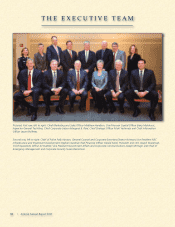Amtrak 2013 Annual Report Download - page 21
Download and view the complete annual report
Please find page 21 of the 2013 Amtrak annual report below. You can navigate through the pages in the report by either clicking on the pages listed below, or by using the keyword search tool below to find specific information within the annual report.
22 | Amtrak Annual Report 2013
through state investments to improve service, speed, and safety. In addition, states and communities
realize stations served by Amtrak are anchors for economic development, catalysts for historic
preservation and tourism growth, sites for commercial and cultural uses, and points of civic pride.
Long-Distance Routes (“LD routes”)
Under the Passenger Rail Investment and Improvement Act of 2008 (“PRIIA”), Congress stated
that long-distance passenger rail is a vital and necessary part of our national transportation system
and economy and that Amtrak should maintain a national passenger rail system, including LD
routes that connect the continental United States from coast to coast and from border to border. We
operate long-distance trains, most of them on a daily basis, on 15 routes. These trains are the only
passenger rail service in 23 of the 46 states we serve. Operating over routes that range up to 2,438
miles in length (the Empire Builder), the long-distance trains serve to connect nearby communities
with one another, with terminal cities, and with other Amtrak services at major hubs such as
Chicago. The majority of coach passengers travel over only portions of these routes. For longer
distance travel, and for trips between the endpoints, we offer sleeping car service (which generates
15% of the passengers and 25% of the ticket revenues on these routes). These trains are heavily
patronized by senior citizens and passengers with disabilities. Ten of our 15 LD routes saw an
increase in riders in FY 2013 and, combined, had the best ridership in 20 years with 4.8 million
passengers. In many places, long-distance trains have helped to “incubate” short-distance corridor
service on portions of their route. Many long-distance trains provide an additional service frequency
on SD routes, offering travelers a greater range of travel options, and combining the needs of
growing state-supported service with the requirement to tie the national system together. The ma-
jority of train-miles traveled by Amtrak on these routes are on the host railroad tracks owned by
freight and commuter railroads.
OTHER BUSINESS
Our other business is comprised of (i) other transportation revenue from use of Amtrak-owned
premises and other services; (ii) revenue from reimbursable engineering and capital improvement
activities; (iii) commercial development revenue from retail, parking, advertising, real property
leases/easements/sales, and right-of-way fees; and (iv) freight access fee revenue from the use of
Amtrak-owned tracks.
RESTATEMENT OF PREVIOUS PERIOD FINANCIAL INFORMATION
During FY 2013, our independent auditor completed its audit of our FY 2012 financial statements
and issued its Report on Internal Control Over Financial Reporting and on Compliance and Other
Matters Based on an Audit of Financial Statements Performed in Accordance with Government
Auditing Standards. This report contained two significant deficiencies related to accounting for
capital leases and accounting for income taxes. In our efforts to remediate these findings, we
performed a comprehensive review of our capital lease accounting and also performed a detailed
analysis to determine if deferred tax liability and valuation allowance accounts were appropriately
computed and disclosed.
As a result of our review, we identified and corrected several errors in our accounting for capital
leases and deferred taxes. While this review was underway, we identified certain other errors in the
prior period financial statements and also corrected those errors. Certain of the adjustments
impacted periods prior to those being presented. We restated the previously issued consolidated
financial statements for FY 2012 in order to correct the errors that occurred during that fiscal year.
























